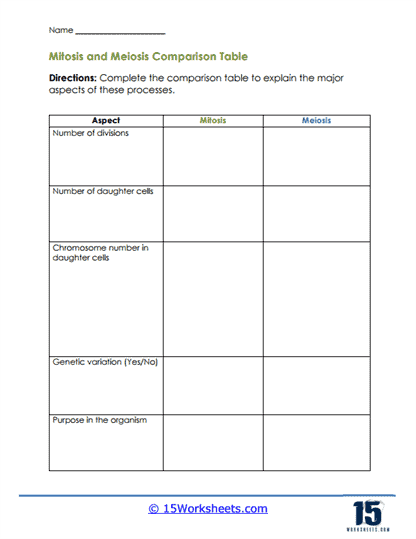Comparison Table

Worksheet Description
This worksheet presents a structured table for students to compare and contrast the primary features of two vital cell division processes: mitosis and meiosis. By examining various aspects like the number of divisions, daughter cells produced, chromosome count in the offspring cells, genetic variability, and the processes’ roles in organisms, the worksheet aims to clarify the differences and similarities between them. The tabular format offers a visual tool that helps in systematically categorizing and understanding these complex biological procedures. A set of directions guides the students to fill in the table based on their knowledge and comprehension of the topics.
To complete the worksheet effectively, students should begin by revisiting their understanding of mitosis and meiosis. Drawing from their knowledge, they should sequentially address each row in the table, filling in the appropriate details for both processes. Comparing the two side by side within the table will aid in distinguishing the unique characteristics and roles each process plays in cell division. Students might find it beneficial to refer to their textbooks or class notes to ensure the accuracy of their entries, especially when delineating the nuanced differences between the two.
The primary intention of this worksheet is to foster a deeper comprehension of the intricacies of mitosis and meiosis among students. It serves as a tool to help them distinguish between these two fundamental biological processes, emphasizing their individual roles, outcomes, and implications. The comparative format encourages critical thinking and analytical skills, guiding students to discern the subtle and overt differences and similarities. By the end, students should be equipped with a clearer, consolidated understanding of the significance and characteristics of both mitosis and meiosis.
